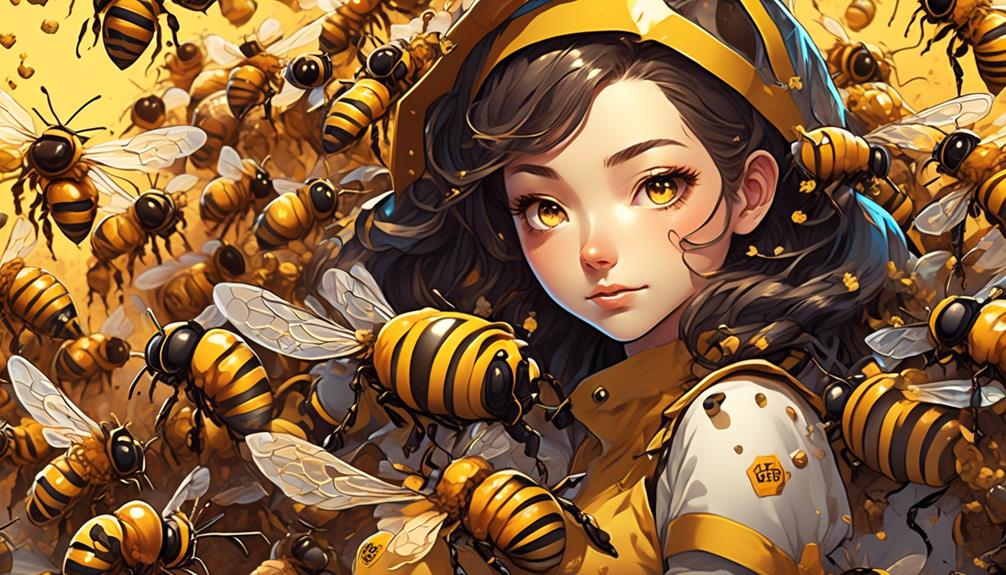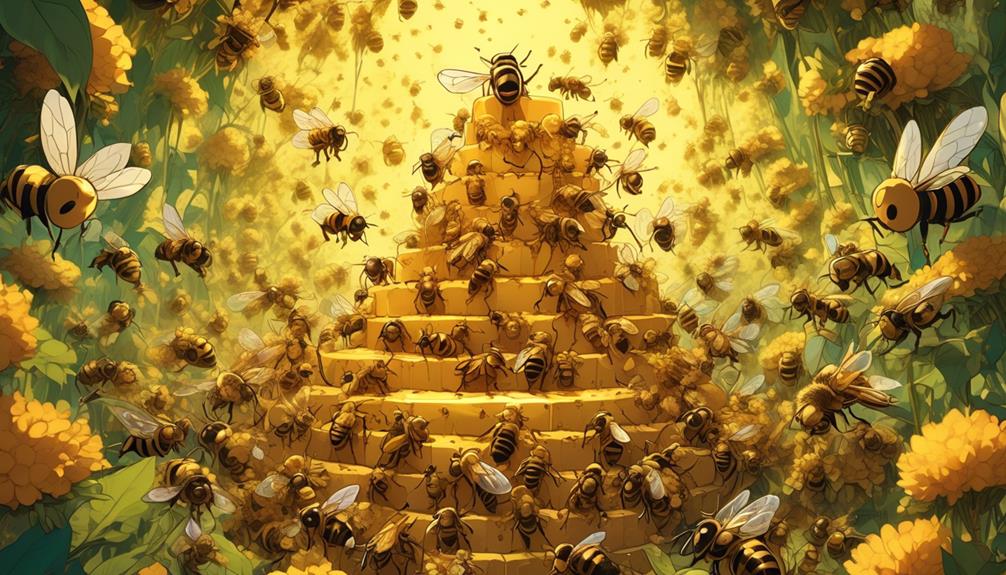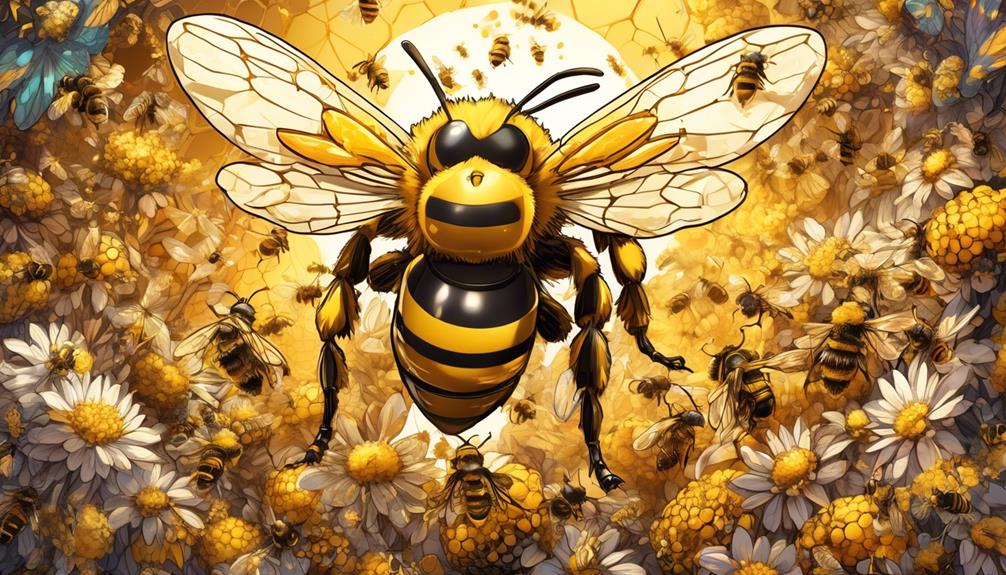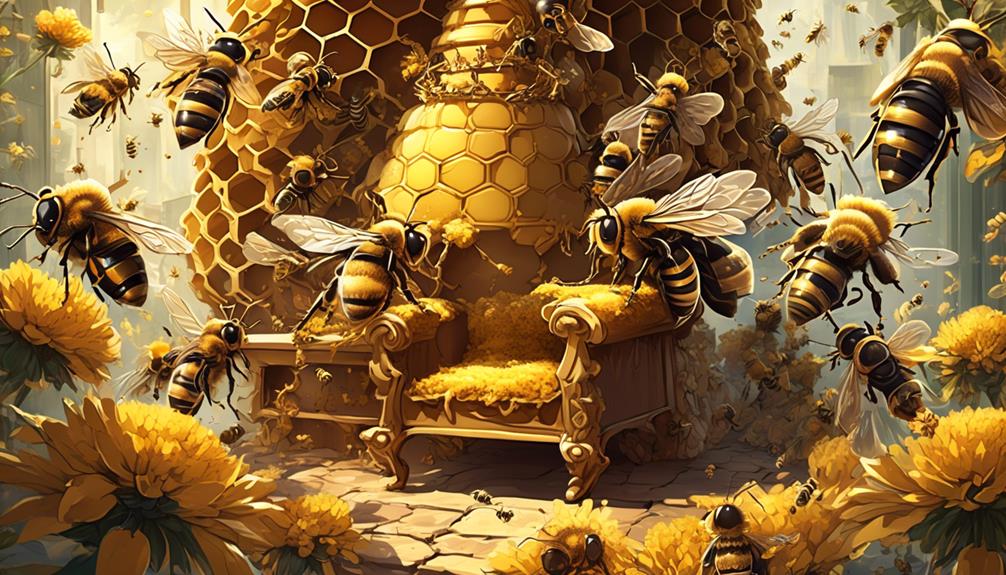Just when you thought you knew bees, discover the fascinating reason behind the absence of a king in their societal structure.

Why Don't Bees Have a King?
You've probably heard of a queen bee, but have you ever wondered why there's no king bee? It's a common misconception that there must be a male counterpart to the queen in a bee colony, akin to human monarchies.
However, the world of bees operates under a different set of societal norms. The absence of a king bee is not an omission or a curious anomaly, it's a fundamental element of bee society.
You're about to discover the intriguing, and somewhat counterintuitive, reasons behind why bees don't have a king, and how this unusual structure contributes to the survival and success of their colonies.
Key Takeaways
- Bees live in colonies with a strict hierarchical system, but there is no king bee.
- The queen bee's primary function is to lay eggs and she is the mother of all bees in the colony.
- Worker bees play a crucial role in the hive's survival by foraging, caring for larvae, and maintaining the hive.
- Male bees, or drones, exist solely to mate with the queen and do not contribute to daily work or raising young ones.
Understanding Bee Societal Structure

To understand why bees don't have a king, it's crucial to delve into the intricacies of their societal structure, which boasts a complexity often underestimated by many. Bees live in colonies and these colonies operate under a strict hierarchical system, with each bee having its specific role.
The queen bee, contrary to popular belief, doesn't rule the colony. She's a reproductive machine whose primary function is to lay eggs. Worker bees, all of which are females, do the bulk of foraging, nursing, and colony maintenance. Drones, the only males, have a solitary purpose: to mate with the queen.
This division of labor isn't random. It's dictated by a bee's genetics and its diet during the larval stage. Worker bees, for instance, are fed a diet of royal jelly, pollen, and nectar, which inhibits their sexual development and gears them towards their role.
You won't find a king bee because male bees don't contribute to the colony's survival beyond reproduction. They don't forage or defend the hive. Without a functional role within the hive, there's simply no need for a king. The bee society is more of a matriarchy than a monarchy.
Role of the Queen Bee

While we've established that there's no king bee and the queen isn't exactly a ruler, it's critical to examine the vital role she plays in the survival and functioning of the bee colony.
The queen bee, once mature, is the only female in the hive with fully developed reproductive organs. Her primary role? To lay eggs – up to 2000 a day during peak season. She's the mother of all bees within the colony, ensuring its continued existence. She also produces pheromones that regulate the behavior and roles of other bees.
Interestingly, worker bees, who are all female and make up the majority of the colony, control the queen's output. They determine the size of the queen's cell and the type of food (royal jelly) she receives, both factors in her development into a queen rather than a worker.
Her reign isn't eternal, though. When she begins to falter in her egg-laying, the workers will raise a new queen. As the old queen's pheromone production drops, this triggers worker bees to construct larger, vertical cells in which new queens are reared – a critical process in the survival of the colony.
Absence of a King Bee

So, why isn't there a king bee in a colony, you might ask? The answer lies in the unique reproductive process of bees. You see, the queen bee is the star player when it comes to reproduction. She's the only one who can lay fertilized eggs that will develop into worker bees or future queens. Male bees, or drones, exist solely to mate with the queen.
In bee colonies, there's no need for a 'king'. A drone's life is short and singularly focused. Once they've performed their single function, they're no longer needed and often die. They don't contribute to the colony's daily work like collecting pollen or nectar, or even help in raising the young ones.
Moreover, the queen doesn't need a constant male partner. She mates with several drones during her nuptial flight and stores their sperm, using it to fertilize eggs throughout her life. Therefore, a 'king' bee would serve no practical purpose in the hive.
Worker Bees: The Real Power

Despite the absence of a king bee, the hive thrives, largely due to the tireless efforts of the worker bees, who truly hold the power in these buzzing societies. You see, worker bees are the backbone of the hive, with roles that are essential to its survival. They're responsible for nearly everything – from foraging for food, to taking care of the larvae, to maintaining the hive's cleanliness.
To understand their importance, let's break down their typical duties. They're divided into two main categories: inside the hive and outside the hive.
Inside the Hive Tasks | Outside the Hive Tasks |
|---|---|
Feeding the larvae | Gathering nectar |
Cleaning the hive | Collecting pollen |
Tending to the queen | Finding water |
Producing beeswax | Guarding the hive |
Analyzing this division of labor, it's clear that without the worker bees, the hive wouldn't function. They're the ones who ensure the hive's survival and prosperity. There's no king in a bee society, but there are thousands of diligent worker bees, and they are the real power. They keep the hive going and make sure that every bee plays its part in the grand scheme of things.
Misconceptions About Bee Hierarchies

You might harbor some misconceptions about bee hierarchies, perhaps picturing a king bee ruling over his subjects, but the reality is far more intricate and fascinating. There's no king bee in a hive; instead, a sole queen bee reigns, but her role isn't as autocratic as you might think.
In bee society, it's the worker bees, all females, who truly run the show. They're the ones who forage for food, care for the larvae, clean the hive, and even decide when it's time for a new queen. They're the backbone of their community, tirelessly performing tasks that ensure the survival of the hive.
Contrary to popular belief, the male bees, or drones, aren't in charge. Their primary purpose is to mate with the queen. After mating, their life ends, dispelling the perception of a ruling king.
The queen bee, while vital for reproduction, doesn't dictate the hive's activities. She's more akin to an egg-laying machine, producing up to 2000 eggs daily to maintain the hive's population.
Understanding these nuances helps dispel the myth of a king bee and reveals the fascinating intricacies of bee society.
Frequently Asked Questions
How Do Bees Communicate With Each Other Within the Hive?
Bees communicate with each other within the hive through a fascinating process called the 'waggle dance'. When a forager bee finds a good source of food, it'll return to the hive and perform this dance.
The pattern of the dance, including the speed and angle, conveys vital details about the location of the food source to the other bees. It's a highly effective, non-verbal communication method they've developed.
What Is the Lifespan of a Typical Bee in a Hive?
You're curious about the typical lifespan of a bee in a hive. It's not a simple answer because it depends on their role.
Worker bees typically live for 5-6 weeks during summer, but can survive for several months during winter.
Queen bees, on the other hand, may live for several years.
Drones, or male bees, have the shortest lifespan, usually 8 weeks or less.
How Does Climate Change or Environmental Factors Impact Bee Society?
Climate change significantly impacts bee societies. When temperatures rise, bees can't regulate their internal body heat and may die.
Changes in weather patterns also disrupt the timing of flower blooming, which bees depend on for food.
Pesticides and habitat loss, due to human activities, further stress bee populations.
Are There Any Other Insects or Animals That Have Similar Societal Structures to Bees?
Yes, there are other insects with similar societal structures to bees. Ants and termites, for instance, have complex societies led by a queen. Just like bees, they operate in colonies where each member has specific duties.
They're governed by pheromones and roles are divided among workers, soldiers, and a reproductive queen.
It's fascinating how these tiny creatures organize themselves in such a structured way, isn't it?
How Do Bees Defend Their Hive From Predators?
When bees sense a threat to their hive, they spring into action. You'll see them swarm the predator, using their stingers to defend their home.
They produce a pheromone when stinging, attracting other bees to join the fight. Some bees even use heat to kill intruders by surrounding and vibrating until the temperature rises.
It's a team effort, each bee playing its part to protect the hive.
Conclusion
So, you see, bees don't have a king because their society doesn't need one. It's the queen bee who's crucial for reproduction, while the worker bees hold the real power, ensuring the hive's survival.
Don't fall for misconceptions about bee hierarchies, they're more complex than they seem. As a marvelous display of social structure in nature, bee colonies teach us about cooperation, division of labor, and the power of collective decision-making.



